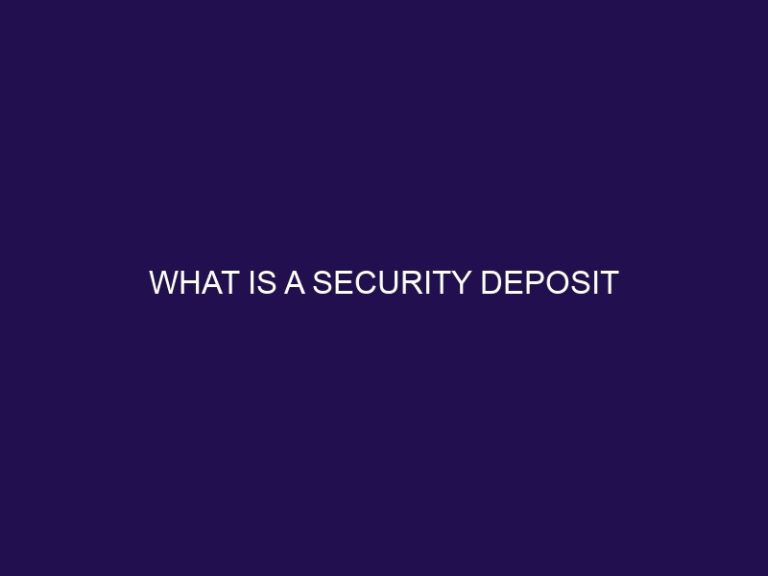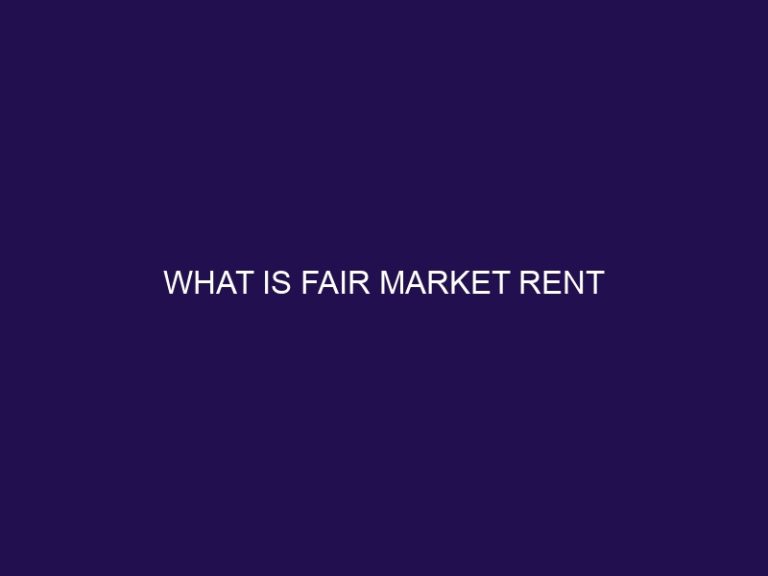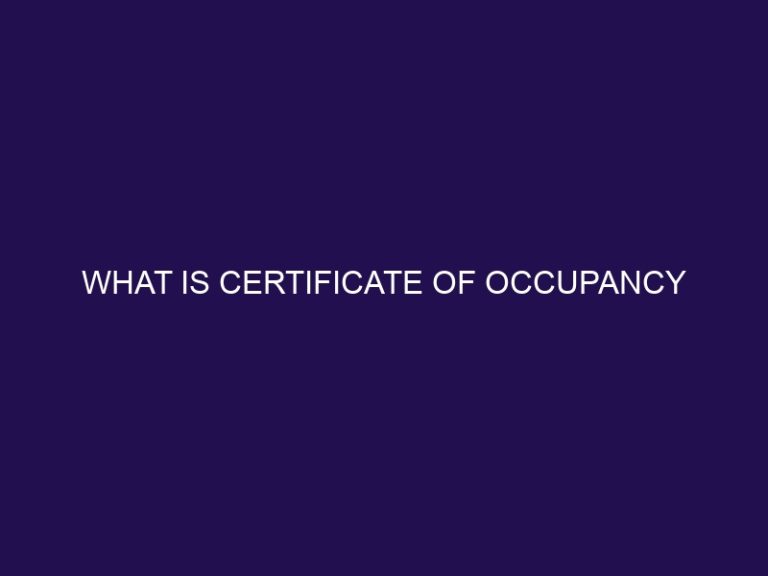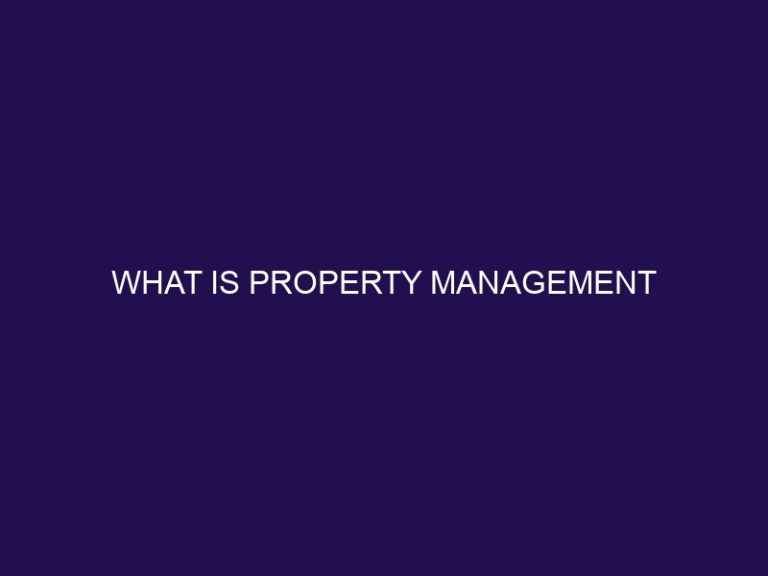What is Estoppel Certificate
Estoppel Certificate is a legal document that plays a significant role in real estate transactions and lease agreements. It provides important information about the rights and obligations of tenants and landlords. Understanding the concept of estoppel is crucial to comprehend the purpose and importance of an estoppel certificate.
Estoppel refers to a legal principle that prevents a party from denying or asserting facts that are contrary to previous statements or actions. In the context of real estate, estoppel applies when a tenant provides written confirmation of certain facts, which the tenant cannot later contradict.
An estoppel certificate, therefore, is a document that outlines the current rights and obligations of a tenant and landlord. It is typically obtained during the process of selling a property or refinancing a loan and provides assurance to potential buyers or lenders about the legal and financial status of the lease.
The purpose of an estoppel certificate is to prevent false claims or misrepresentations from either party during a real estate transaction. It ensures that all parties involved have accurate information regarding the terms and conditions of the lease.
The key information included in an estoppel certificate includes tenant information, lease terms, rent payments and arrears, and any other agreements that may affect the lease. This comprehensive document allows potential buyers or lenders to make informed decisions based on accurate and up-to-date information.
There are several legal considerations to keep in mind when dealing with estoppel certificates. These include the enforceability of the certificate, the reliance and non-reliance on the provided information, and the rights and obligations of third-party beneficiaries.
To obtain an estoppel certificate, the requesting party, often the buyer or lender, needs to submit a formal request to the tenant. The timeframe to obtain the certificate and any associated fees will vary depending on the jurisdiction and the specific circumstances of the transaction.
Understanding Estoppel Certificate
An estoppel certificate is a legal document that is crucial in real estate transactions. It helps clarify and confirm the rights and obligations of parties involved, ensuring transparency and clarity. This document, commonly used in lease agreements or property sales, plays a vital role in protecting both the buyer and seller from misunderstandings or misrepresentations. Understanding the estoppel certificate is essential as it provides detailed information about the lease terms, including rental payments, utilities, and other important aspects. Additionally, it ensures that there are no hidden liabilities or claims on the property.
What is Estoppel?
Estoppel is a legal doctrine that prevents a party from asserting a claim or right that is inconsistent with their prior actions or statements. A key concept in contract law, it aims to ensure fairness and prevent injustice. In the context of real estate, an estoppel certificate, which is the focus of this discussion, is a document that confirms the rights, obligations, and other important details of a lease or rental agreement. So, what is estoppel exactly? Estoppel serves as a safeguard in property transactions and financing endeavors by providing a clear snapshot of the lease terms, rent payments, and other agreements. This allows all parties involved to protect their interests and avoid any potential conflicts.
What is an Estoppel Certificate?
An estoppel certificate, also known as a “What is an Estoppel Certificate?” document, is a legal instrument that authentically verifies the details about a lease agreement between a tenant and a landlord. It plays a crucial role in real estate transactions by ensuring potential buyers or lenders have a clear understanding of the terms and conditions of the lease. Within the certificate, comprehensive information such as tenant particulars, lease terms, rent payments, and any additional agreements between the involved parties is provided. Its primary purpose is to prevent the tenant from making any claims that contradict the information explicitly outlined in the certificate. The process of obtaining an estoppel certificate usually involves requesting it from the tenant while adhering to the specified timeframe and applicable fees. Ultimately, an estoppel certificate acts as an indispensable tool to promote transparency and safeguard the interests of all the parties associated with a lease agreement.
Purpose and Importance of Estoppel Certificates
Estoppel certificates serve a vital purpose and hold great importance in real estate transactions. They are legally binding documents used to verify the accuracy of lease terms and financial obligations between a tenant and a landlord. These certificates play a crucial role during property sales as they provide potential buyers with a comprehensive understanding of the property’s existing lease agreements. For tenants, estoppel certificates hold immense importance as they protect their rights by preventing landlords from making false claims or changing lease terms without consent. The purpose and importance of estoppel certificates are evident in their ability to ensure transparency, minimize disputes, and facilitate smooth and informed real estate transactions.
Why are Estoppel Certificates Used?
Estoppel certificates are utilized for a variety of purposes in legal and business contexts. The primary reasons for their use include ensuring the accuracy and reliability of information, facilitating property transactions, protecting the parties involved, and establishing the legal enforceability of the agreements. In terms of accuracy and reliability, estoppel certificates serve as written statements provided by tenants that outline the details of their lease agreement, encompassing rent payments, lease terms, and any additional agreements. This documentation plays a crucial role in preventing misunderstandings and disputes. Additionally, during property sales or refinancing, estoppel certificates are often required as they enable buyers and lenders to verify the current status of lease agreements and any outstanding financial obligations. The reliance on these certificates offers a layer of protection for all parties involved. Landlords, tenants, and third parties can safeguard their legal interests by obtaining estoppel certificates, which prevent tenants from denying the terms of their lease and provide a clear snapshot of the lease agreement within the transaction. Moreover, estoppel certificates hold significant weight as evidence in legal proceedings by establishing the rights and obligations of the parties involved. When tenants provide these certificates, they formally acknowledge the stated facts, making it arduous for them to later argue against them. Ultimately, estoppel certificates offer clarity and certainty within lease agreements and property transactions, ensuring the protection of the interests of all parties involved.
Who is Involved in Estoppel Certificates?
Who is Involved in Estoppel Certificates?
When dealing with estoppel certificates, several parties are involved in the process.
| 1. Tenant: | The individual or company leasing the property is the tenant and plays a crucial role in providing information related to their lease agreement. |
|---|---|
| 2. Landlord: | The landlord or property owner is responsible for issuing the estoppel certificate to the tenant. They provide essential information about the lease and its terms. |
| 3. Property Management Company: | In cases where the property is managed by a company, they may also be involved in the preparation and issuance of the estoppel certificate. |
| 4. Lender or Financial Institution: | If the property is subject to a mortgage or loan, the lender may require an estoppel certificate to confirm the tenant’s rent payments and other lease details. |
| 5. Legal Counsel: | Both the tenant and landlord may choose to involve their legal representatives to ensure compliance with legal requirements and protection of their interests. |
Each party’s involvement is essential to ensure accurate and valid information is included in the estoppel certificate.
Key Information in an Estoppel Certificate
When it comes to understanding an estoppel certificate, it’s crucial to grasp the key information that it entails. From tenant information to lease terms, rent payments, and other agreements, each sub-section of the estoppel certificate provides essential details that shape the legal landscape. So, let’s dive into this comprehensive overview and uncover the valuable insights that these sections hold, shedding light on crucial facts, figures, and events relevant to the subject matter.
Tenant Information
When obtaining an estoppel certificate, it is vital to consider the tenant information. This encompasses details like the tenant’s name, contact information, and lease agreement. Here are some crucial points to keep in mind:
- Ensure that the name provided matches the official lease agreement.
- Contact Details: Include the tenant’s address, phone number, and email for effective communication.
- Lease Terms: Clearly outline the lease’s start and end dates, along with any renewal options or special clauses.
- Rent Payments and Arrears: Document the current rent amount, payment frequency, and any outstanding arrears.
- Other Agreements: Incorporate any additional agreements between the landlord and the tenant, such as maintenance responsibilities or allowances.
By capturing accurate tenant information, the estoppel certificate provides a comprehensive understanding of the lease agreement and ensures a smooth transaction for all parties involved.
Lease Terms
Lease terms are a crucial element of an estoppel certificate, which serves to verify the terms and conditions outlined in a lease agreement. When pondering lease terms, it is essential to:
- Thoroughly evaluate the duration of the lease, encompassing both the start and end dates.
- Gain a clear understanding of the rent amount, its frequency, and any potential escalations or discounts associated with it.
- Take note of any supplementary charges, such as maintenance fees or utilities.
- Stay informed about any restrictions or prohibitions imposed by the lease agreement.
- Carefully consider the available options for lease renewal or the presence of termination clauses.
By diligently examining lease terms, both tenants and landlords can ensure transparency and mitigate any potential misunderstandings. It is highly recommended to seek guidance from legal professionals to fully comprehend the implications of lease terms and safeguard one’s interests.
Rent Payments and Arrears
When it comes to rent payments and arrears, estoppel certificates are crucial for providing accurate information and ensuring transparency between tenants and landlords.
- Rent Amount: The estoppel certificate specifies the agreed-upon rent amount for a specific period.
- Payment: It includes details of rent payments made by the tenant, ensuring that all payments are accurately recorded.
- Arrears: The certificate outlines any outstanding rent or arrears that the tenant needs to settle.
- Terms and Conditions: It includes information about any penalty fees or late payment charges associated with rent payments and arrears.
- Confirmation: The certificate serves as confirmation that the tenant is not aware of any payment discrepancies or disputes.
Other Agreements
One vital aspect of an estoppel certificate is to incorporate information about any “other agreements” that are connected to the lease. These “other agreements” may comprise of modifications, amendments, or addendums that have been implemented to the original lease. By including this information, the parties involved can guarantee that all terms and conditions are accurately represented in the certificate. This inclusion can effectively prevent any future misunderstandings or disputes. It is of utmost importance to provide truthful and current information about these “other agreements” in order to uphold the integrity of the estoppel certificate and establish clear expectations between the involved parties.
Pro-tip: When completing an estoppel certificate, make sure to meticulously review all lease-related documents to identify any additional “other agreements” that should be incorporated. This will ensure that no significant details are overlooked.
Legal Considerations for Estoppel Certificates
Discover the key aspects that make estoppel certificates influential in real estate transactions. From enforceability to reliance and non-reliance, as well as the significance for third-party beneficiaries, we’ll explore the vital legal factors surrounding estoppel certificates. Uncover the impact and use of these certificates in ensuring transparency and stability in property transfers.
Enforceability
When it comes to estoppel certificates, the enforceability of these documents is a crucial aspect to consider. The enforceability of an estoppel certificate refers to its legal validity and binding nature. These certificates serve as important legal documents that confirm the accuracy of certain facts related to a lease or agreement. They are typically relied upon by third parties, such as lenders or buyers, in real estate transactions. The enforceability of an estoppel certificate ensures that the parties involved can trust the information provided and can use it as a basis for their actions. Therefore, it is important to ensure that the estoppel certificate meets all legal requirements to ensure its enforceability.
When dealing with estoppel certificates, it is essential to understand and ensure their enforceability. This will help maintain trust and reliability in real estate transactions, benefiting all parties involved. To ensure the enforceability of estoppel certificates, it is advisable to consult legal professionals who specialize in this area of law. They can provide guidance and ensure that the estoppel certificate meets all necessary legal standards. Additionally, keeping accurate records and documentation can further enhance the credibility of the certificate, supporting its enforceability. Therefore, it is important to maintain thorough and organized documentation throughout the process.
Overall, the enforceability of estoppel certificates is crucial in real estate transactions. By ensuring their enforceability, all parties involved can have confidence in the accuracy of the information provided and can proceed with their actions accordingly.
Reliance and Non-Reliance
Relevance and absence of reliance are significant considerations when dealing with Estoppel Certificates in a legal context.
In an Estoppel Certificate, the party providing the certificate (usually a tenant) affirms the accuracy of certain information and consents that the recipient (usually a landlord or lender) can depend on it. This establishes a legal relationship of trust, where the recipient can rely on and take action based on the information provided. It is essential to include a clause of non-reliance to safeguard the party providing the certificate from any claims or liabilities that may arise from the recipient’s reliance on inaccurate or incomplete information.
Here is a
| Trust | Non-Reliance |
|---|---|
| The recipient can trust the accuracy of the information provided in the Estoppel Certificate. | The party providing the certificate is not accountable for any losses or damages resulting from the recipient’s reliance on the certificate. |
| The recipient can present the certificate as evidence in legal proceedings if the information provided is inaccurate or false. | The party providing the certificate cannot be held responsible if the recipient relies on outdated or incomplete information. |
| Trust ensures trust and transparency between the parties involved, facilitating smoother transactions, and negotiations. | Non-reliance protects the party providing the certificate from potential legal consequences due to the recipient’s reliance on the information provided. |
By comprehending the implications of trust and incorporating a non-reliance clause, the parties involved can establish clear and mutually beneficial agreements concerning Estoppel Certificates.
Third-Party Beneficiaries
“`
| Third-Party Beneficiaries |
| A third-party beneficiary is a person or entity who is not a party to the original contract, but benefits from its terms. |
| In the context of estoppel certificates, third-party beneficiaries can include lenders, buyers, or other parties with an interest in the property. |
| These beneficiaries rely on the information provided in the estoppel certificate to make informed decisions regarding their involvement with the property or transaction. |
| The information provided in the certificate, such as rent arrears or other agreements, can impact the negotiations and terms of their agreements. |
| By including third-party beneficiaries, estoppel certificates ensure transparency and protect the rights and interests of all parties involved in the transaction. |
“`
How to Obtain an Estoppel Certificate
Looking to obtain an estoppel certificate? Wondering about the process, timeframe, and fees involved? In this section, we’ll dive into the nitty-gritty of how to obtain an estoppel certificate. From making the request to understanding the necessary timeframes and associated costs, we’ve got you covered. So, let’s get started on demystifying the steps you need to take to secure that all-important estoppel certificate. No more confusion, just clear guidance and valuable insights at your fingertips.
Requesting an Estoppel Certificate
- When requesting an estoppel certificate, it is important to follow these steps:
- Contact the tenant or property management to politely request the estoppel certificate.
- Provide all necessary information, including the property address, tenant name, and lease details.
- Specify the deadline by which you need the estoppel certificate.
- Submit any required fees or documentation promptly.
- It is crucial to follow up with the tenant or property management to ensure the timely delivery of the certificate.
Remember, maintaining a polite and professional approach throughout the process greatly impacts the success of your transaction. Prompt and efficient handling of the request for an estoppel certificate is essential for smooth real estate dealings.
Timeframe and Fees
When obtaining an estoppel certificate, it is of utmost importance to carefully consider both the timeframe within which it needs to be acquired and any fees involved. Here are the necessary steps to follow when obtaining an estoppel certificate:
- Requesting the certificate: Begin by reaching out to the relevant party, such as the landlord or property management company, to formally request the estoppel certificate.
- Providing required information: Make sure to come prepared with all the necessary details, which include your name, lease terms, rent payment history, as well as any other agreements or obligations that may be pertinent.
- Reviewing and signing: It is crucial to carefully review the estoppel certificate for accuracy and completeness. Once you are satisfied, affix your signature and promptly return it within the specified timeframe.
- Considering the time and fees: Be sure to take into account the allocated timeframe that is available for obtaining the estoppel certificate, as well as any associated fees that may be applicable.
Frequently Asked Questions
What is an estoppel certificate?
An estoppel certificate is a document used in real estate and mortgage transactions to verify certain representations made by the landlord or tenant to a third party. It confirms important details of a commercial lease agreement, such as rent payment, lease duration, and any potential claims against the landlord.
Why do commercial landlords require an estoppel certificate?
Commercial landlords require an estoppel certificate to prove the enforceability of the lease to lenders, investors, or potential buyers. It provides additional security by ensuring that the tenant will fulfill their promises and that the landlord will not change the agreed-upon terms.
What information does an estoppel certificate include?
An estoppel certificate includes details such as the lease start and end dates, rent amount and due date, confirmation of no defaults, any modifications to the lease, the tenant’s ability to lease other space in the building, and contact information. It may also cover lease renewals, breaches of responsibilities, or relinquishment of rights.
What happens if a tenant fails to sign or return the estoppel certificate?
If a tenant fails to sign or return the estoppel certificate within the specified time frame, the lease may allow the landlord to complete the certificate on behalf of the tenant, consider the tenant’s silence as consent, or impose a monetary penalty. Tenants are generally obligated to sign the estoppel certificate to avoid legal consequences.
How can I obtain a copy of the lease for the estoppel certificate?
To obtain a copy of the lease, you can contact the Office of Administrative Counsel at house.leases@mail.house.gov or 202-225-6969. They will provide you with the necessary information and documentation.
Should the estoppel certificate mention a security deposit?
No, there should be no mention of a security deposit in the estoppel certificate. It primarily focuses on verifying lease terms and confirming rent payment, rather than addressing financial transactions like security deposits.







